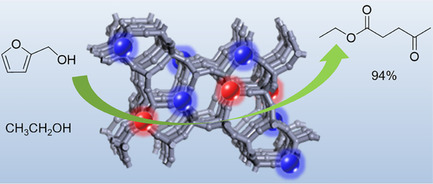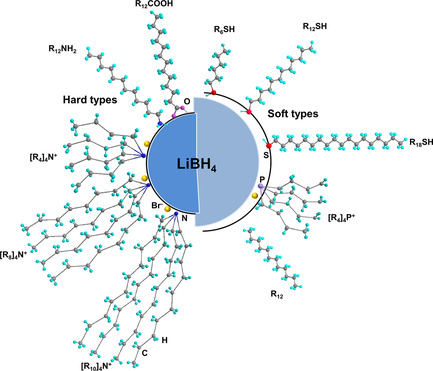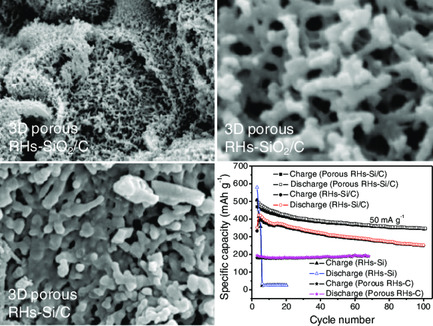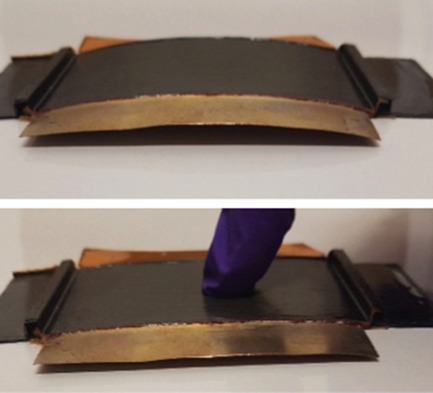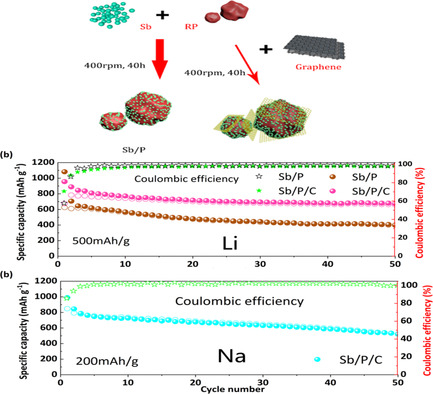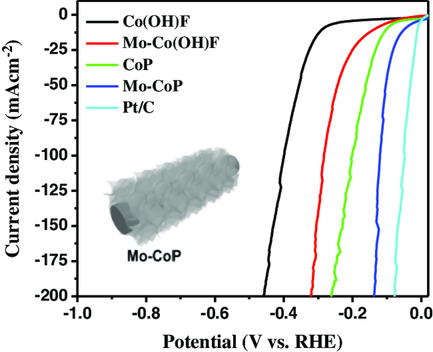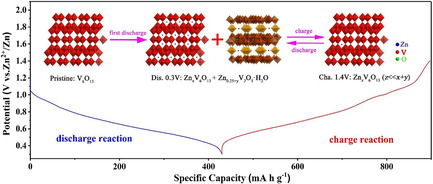Journal list menu
Export Citations
Download PDFs
Cover Picture
Solar Green Roofs: A Unified Outlook 20 Years On
- First Published: 11 June 2019

Solar green roofs, equipped with specific living vegetation and photovoltaic modules, ideally combine environmental and economic benefits and comply with the ongoing shift to distributed renewable power generation. Roof-based solar power generation is quickly expanding, bringing a range of environmental, health, aesthetic, and economic benefits. More details can be found in article number 1900128 by Francesco Meneguzzo, Mario Pagliaro, and co-workers.
Masthead
Reviews
Solar Green Roofs: A Unified Outlook 20 Years On
- First Published: 09 March 2019

Solar green roofs, equipped with properly selected living vegetation and photovoltaic modules, ideally combine environmental and economic benefits and comply with the ongoing shift to distributed renewable power generation. While proper education is still lagging behind, roof-based solar power generation is quickly expanding, along with the related ecosystem services, involving air pollution and health, renewable energy, biodiversity, and aesthetics.
Decomposition of Methane to Carbon and Hydrogen: A Catalytic Perspective
- First Published: 02 September 2018
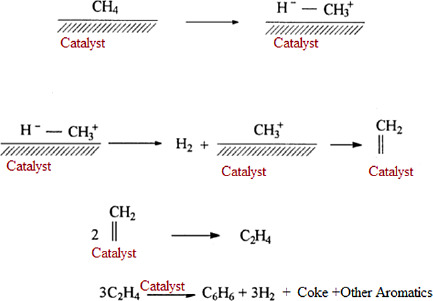
Catalytic methane decomposition serves as a route for formation of various hydrocarbons. This review looks at the methane decomposition taking into account thermodynamics, kinetics, and product distribution. Carbon nanomaterials and other hydrocarbons are identified as valuable products obtainable from methane decomposition and its succeeding reactions. Factors affecting catalyst performance are discussed. Methane decomposition could yield high purity hydrogen.
Application of X-Ray Computed Tomography Technology in Gas Hydrate
- First Published: 04 November 2018

The application of X-ray computed tomography (CT) in natural gas hydrate is summarized from the following perspectives: analyzing the basic physical properties of hydrate sediment, identifying the occurrence mode of hydrate in sediments, measuring the hydrate formation and decomposition process. In response to the research progress and future research directions, relevant suggestions are put forward.
Separator Membranes for Lithium–Sulfur Batteries: Design Principles, Structure, and Performance
- First Published: 08 January 2019
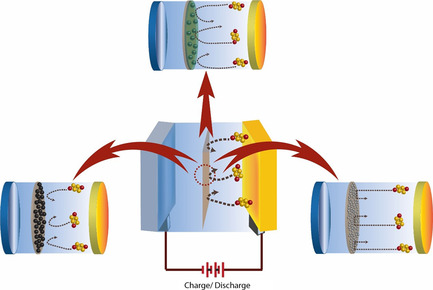
Three general design principles have been utilized in literature to decelerate polysulfide shuttle in Li-S batteries, namely physical absorption, chemisorption, and electrostatic repulsion. These three principles are schematically shown. They are invoked either individually or in combination to obtain an efficient working Li-S battery.
Communications
One-Step Synthesis of MoS2 Nanosheet Arrays on 3D Carbon Fiber Felts as a Highly Efficient Catalyst for the Hydrogen Evolution Reaction
- First Published: 03 April 2019

MoS2 nanosheets are uniformly scratched to carbon fiber felt (CFF) by a one-step hydrothermal reaction to form a high-stability composite catalyst with a self-supporting structure. The unique structure of CFF allows the MoS2 nanosheets to grow in situ, avoiding a large amount of stacks between the layers. Also, the electrochemical measurement exhibits that the MoS2/CFF composite has an excellent hydrogen evolution reaction (HER) activity.
Synergy of B and Al Dopants in Mesoporous MFI Nanocrystals for Highly Selective Alcoholysis of Furfuryl Alcohol into Ethyl Levulinate
- First Published: 09 April 2019
Full Papers
Controlling the Growth of LiBH4 Nanoparticles for Hydrogen Storage
- First Published: 21 February 2019
Rice Husk-Based 3D Porous Silicon/Carbon Nanocomposites as Anode for Lithium-Ion Batteries
- First Published: 14 February 2019
A Novel Arch-Shaped Hybrid Composite Triboelectric Generator Using Carbon Fiber Reinforced Polymers
- First Published: 25 April 2019
Synthesis and Electrochemical Research of Milled Antimony and Red Phosphorus Hybrid Inlaid with Graphene Sheets as Anodes for Lithium–Sodium Storage
- First Published: 19 February 2019
Self-Assembled CoFe Nanoparticle-Embedded Carbon Nanowires as Efficient Nonprecious Catalyst for Overall Water Splitting
- First Published: 28 February 2019
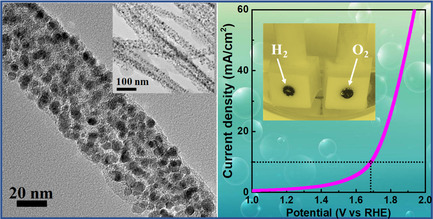
Self-assembled CoFe@CNWs are used as efficient electrocatalysts for overall water splitting. The excellent electrocatalytic performance of CoFe@CNWs is attributed to its unique porous nanoarchitecture, constructed by ultrasmall conductive CoFe nanoparticles homogenously embedded in highly conductive carbon nanowires. This work provides a strategy to rationally design and synthesize a nanostructured transition metal–based hybrid as a highly effective and stable nonprecious electrocatalyst.
All-Sprayable Hierarchically Nanostructured Conducting Polymer Hydrogel for Massively Manufactured Flexible All-Solid-State Supercapacitor
- First Published: 29 March 2019

Polyaniline–phytic acid conductive polymer hydrogels with 3D hierarchical interconnected coral-like structures are successfully designed. This hydrogel can be massively sprayed for the fabrication of high-performance flexible solid-state supercapacitors. As a result, such a supercapacitor achieves a highly areal capacitance (91 mF cm−2 at 1 mA cm−2) and an excellent cycling stability (93.5% capacitance retention over 10 000 charge–discharge cycles).
Development of Bifunctional Hydrodeoxygenation Catalyst Rh-HY for the Generation of Biomass-Derived High-Energy-Density Fuels
- First Published: 27 February 2019
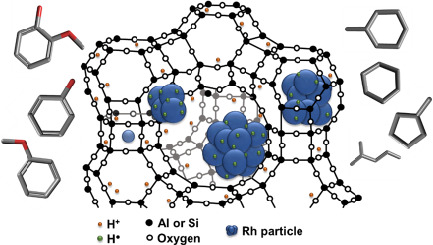
Liquid-phase, high-pressure hydrodeoxygenation (HDO) of lignin-model compounds is performed using Rh-doped zeolite catalysts to generate cyclohexane as the main HDO product. Modest increases in Rh loading extend the catalyst life and increase its activity and selectivity. Though the catalyst deactivation rate must be curbed further, these results indicate that bifunctional Rh-HY catalysts constitute a promising alternative for upgrading lignin-derived biomass.
Synergistic Effects of Mo2C-NC@CoxFey Core–Shell Nanoparticles in Electrocatalytic Overall Water Splitting Reaction
- First Published: 20 February 2019
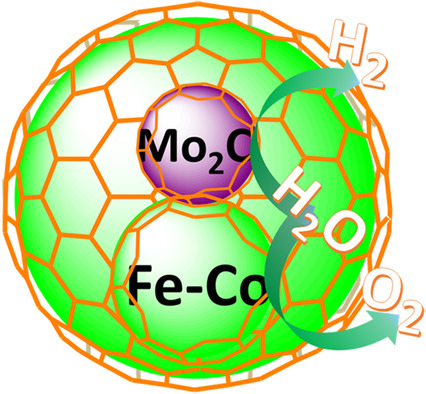
CoxFey nanoparticles embedded in a N-doped graphene shell containing coupled Mo2C-nanoparticles are efficient bifunctional electrocatalysts for the overall water splitting due to synergistic electronic and structural effects. These core–shell materials show potentials as low as 1.53 and 1.60 V at 10 and 20 mA cm−2 in alkaline media, which are far better compared to cells based on precious metals.
Stable Active Sites on Ni12P5 Surfaces for the Hydrogen Evolution Reaction
- First Published: 17 April 2019
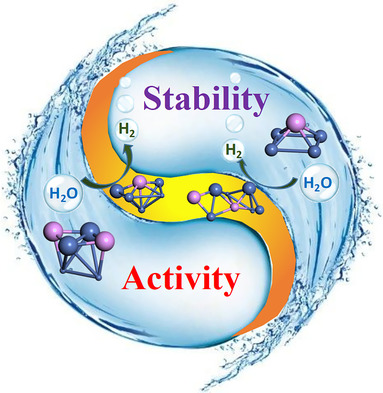
A comprehensive analysis of the fundamental reasons behind the catalytic activity and chemical stability of Ni12P5 surfaces is conducted. This study supports the idea that catalytically active and chemically stable sites are not mutually exclusive; the (101) surface of Ni12P5 with P-rich termination shows the best stability and activity for hydrogen evolution reactions.
Mo-Doped Cobalt Phosphide Nanosheets for Efficient Hydrogen Generation in an Alkaline Media
- First Published: 18 March 2019
Development of a Structured Reactor System for CO2 Methanation under Dynamic Operating Conditions
- First Published: 16 April 2019

The use of an additively manufactured rack-type reactor for CO2 methanation under dynamic operating conditions is proposed. The additively manufactured structured reactor (catalyst: 2.5 wt% Ru/Al2O3/MgO) combines a high heat conductivity of the metallic structures with equilibrium CO2-conversions for various loads and thus offers a high potential for the dynamic operation of exothermic gas-phase processes.
Intercalated Graphite between Ni Foam and Ni3S2 Nanocrystals for the Activity Promotion in Overall Water Splitting
- First Published: 05 March 2019
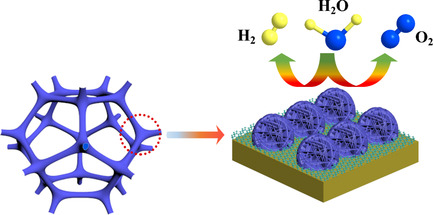
A novel Ni3S2@GF@NF free-standing electrode is fabricated by chemical vapor deposition and a hydrothermal method. The obtained Ni3S2@GF@NF composite exhibits enhanced catalytic activity in the hydrogen evolution reaction and oxygen evolution reaction compared with Ni3S2@NF. It could also be used as a bifunctional electrode to effectively perform overall water splitting.
Rational Design of Manganese Cobalt Phosphide with Yolk–Shell Structure for Overall Water Splitting
- First Published: 19 March 2019
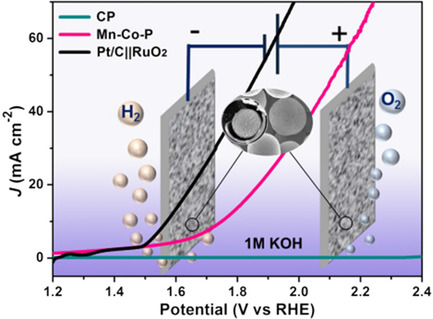
The Mn-Co-P spheres with a yolk–shell structure synthesized by a facile hydrothermal route exhibit excellent performance toward both the hydrogen evolution reaction and oxygen evolution reaction. The outstanding catalytic activity of the assembled electrolyzer for overall water splitting suggests an extensive application prospect of Mn-Co-P as non-noble transition metal catalysts in the electrocatalytic fields.
Pressure-Induced Vapor Synthesis of Carbon-Encapsulated SiOx/C Composite Spheres with Optimized Composition for Long-Life, High-Rate, and High-Areal-Capacity Lithium-Ion Battery Anodes
- First Published: 04 March 2019
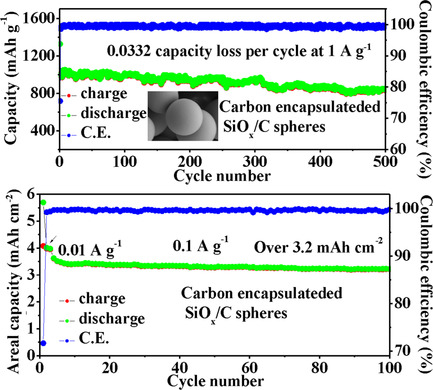
The SiOx/C composite spheres are synthesized by a high pressure caused by pyrolysis of different liquid siloxanes and hexamethyldisilane in a sealed vessel and subsequent heat treatment. As anodes for a lithium-ion battery, the SiOx/C composite spheres show an outstanding cycling stability and high areal capacity (4.08 mAh cm−2) after optimizing their composition and encapsulating with carbon layers under a high pressure.
Hollow NaTi1.9Sn0.1(PO4)3@C Nanoparticles for Anodes of Sodium-Ion Batteries with Superior Rate and Cycling Properties
- First Published: 23 February 2019
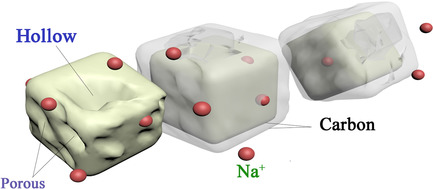
The herein reported NTSP@C has three important characteristics: 1) abundant pores are conducive to fast Na+ transport and relieve volume expansion during sodiation/desodiation; 2) larger ionic radius of tin further broadens the sodium ion transport channels and makes the migration of sodium ions in active materials smoother; 3) high-efficient conductive carbon improves the electronic conductivity of the active material.
Hierarchical Ni(HCO3)2 Nanosheets Anchored on Carbon Nanofibers as Binder-Free Anodes for Lithium-Ion Batteries
- First Published: 02 April 2019
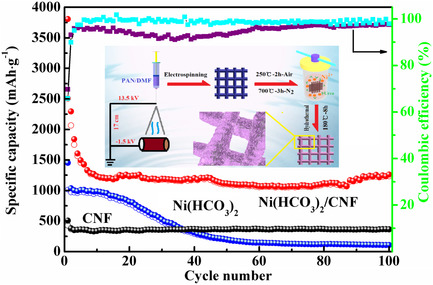
Ni(HCO3)2 nanosheets anchored on carbon nanofibers are designed that exhibit excellent lithium storage performance with a high cycling stability and good rate capability. This work may shed light on the preparation of other binder-free transition metal carbonates and make them as high-performance electrodes in flexible electronic devices.
Synergistic Effects of BaTiO3/Multiwall Carbon Nanotube as Fillers on the Electrical Performance of Triboelectric Nanogenerator Based on Polydimethylsiloxane Composite Films
- First Published: 15 March 2019

Triboelectric nanogenerators based on BT-multiwall carbon nanotube (MWCNT)/polydimethylsiloxane (PDMS) composite films are designed at different BaTiO3 sizes and mass ratios. Synergistic effects of BaTiO3/MWCNT fillers on the triboelectric output performance are studied. As to BT-70-MWCNT/PDMS composites, with the same mass ratio of BT, the peak output current is always higher than that of BT-500-MWCNT/PDMS.
Balancing Porosity and Oxygen-Containing Functionalities of Hierarchically Porous Carbons for Enhanced Capacitive Supercapacitors
- First Published: 25 February 2019
Vertical-Space-Limit Synthesis of Bifunctional Fe, N-Codoped 2D Multilayer Graphene Electrocatalysts for Zn-Air Battery
- First Published: 27 February 2019
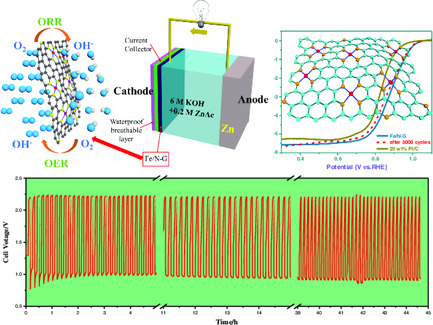
A bifunctional Fe, N-codoped 2D multilayer graphene (Fe/N-G) electrocatalyst possesses an excellent oxygen evolution and reduction reaction activity and durability owing to the spatial confinement of H-MMT, which increases the content of active sites including in-plane Fe-Nx pyridinic N and pyrrolic N in the Fe/N-G. This high-performance bifunctional Fe/N-G electrocatalyst has promising applications in the field of rechargeable Zn-air batteries.
Coordination Engineering Construction of Si@ZnS@N,S-Doped Reduced Graphene Oxide Nanocomposite as Anode Material with Enhanced Lithium Storage Performance
- First Published: 13 March 2019
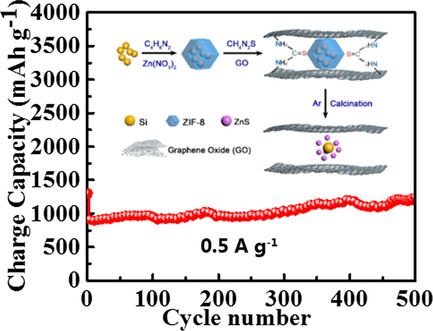
Si@ZnS@rGO is prepared by the one-step vulcanization of Si@ZIF-8@rGO. In the composite, similar electrochemical behaviors of Si and ZnS make ZnS a good buffer layer for Si during charge/discharge; the high specific capacity of ZnS helps upgrade the capacity of the composite, and the ZnS shell enhances the ionic conductivity of the composite material, which results in a good electrochemical performance.
Compressed and Crumpled Porous Carbon Electrode for High Volumetric Performance Electrical Double-Layer Capacitors
- First Published: 26 March 2019
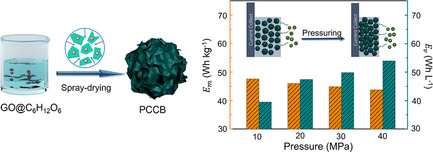
Porous crumple carbon balls (PCCBs) assembled from 2D carbon sheet material are obtained with excellent packing density, high ion-accessible surface area, and short ion-diffusion pathways using an aerosol drying device. The PCCB electrodes pressured at 40 MPa show an increase in the density (1.23 g cm−3). The volumetric energy density of PCCB-based EDLC devices can reach 53.9 Wh L−1.
On the Feasibility of Using Hierarchical ZSM-5 and Beta Zeolites as Supports of Metal Phosphides for Catalytic Hydrodeoxygenation of Phenol
- First Published: 18 March 2019
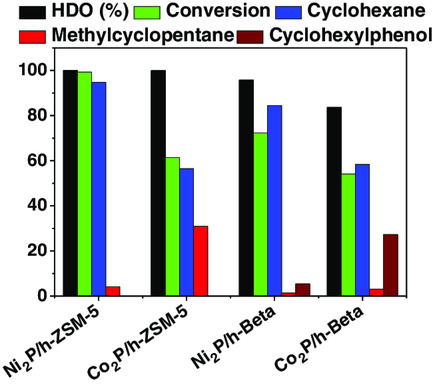
Hierarchical h-ZSM-5 and h-beta zeolites are assessed as supports of metal phosphides (Ni2P and Co2P) and tested in phenol hydrodeoxygenation (HDO). Ni2P/h-ZSM-5 exhibited the best performance due to the high hydrogenation activity of Ni2P and to the preservation of the support mesoporosity, which favours the dispersion of the metal phosphide nanoparticles and the accessibility to the active sites.
Spray-Assisted Synthesis of MnO@C/Graphene Composites as Electrode Materials for Supercapacitors
- First Published: 26 September 2018

MnO@C/rGO composite spheres are prepared with a spray-drying technique and followed by calcination. The as-prepared MnO@C/rGO composite exhibits a high specific capacitance of 264 F g−1 at a current density of 1 A g−1 and a rate-capability retention of about 67% when the current density soared from 1 to 20 A g−1.
Facile Synthesis of Binary Transition Metal Sulfide Tubes Derived from NiCo-MOF-74 for High-Performance Supercapacitors
- First Published: 31 January 2019

Herein, NiCo-oxide with hollow tubular structures is obtained via an annealing process with NiCo-MOF-74 as a precursor. The NiCo-oxide transforms into NiCo-sulfide tubes with a nanosheet structure during the solvothermal treatment, and the specific structure of NiCo-sulfide contributes to its high specific capacitance, good rate capability, and cycling stability.
Highly Reversible Phase Transition Endows V6O13 with Enhanced Performance as Aqueous Zinc-Ion Battery Cathode
- First Published: 31 January 2019
Cover Picture
Controlling the Growth of LiBH4 Nanoparticles for Hydrogen Storage
- First Published: 11 June 2019
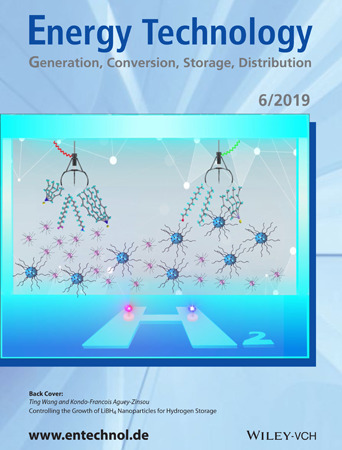
LiBH4 is a promising material to store high-density hydrogen reversibly. This work shows that the particle size of LiBH4 can be controlled by an appropriate choice of stabilizing surfactant. This is an important step in the development of better strategic methods to control the core–shell synthesis of hydrogen storage materials. The cover image shows a claw machine that can effectively pick up LiBH4 nanoparticles with different surfactants. The left and right claws represent hard and soft type surfactants which tend to grab small and large LiBH4 nanoparticles, respectively. More details can be found in article number 1801159 by Ting Wang and Kondo-Francois Aguey-Zinsou.





